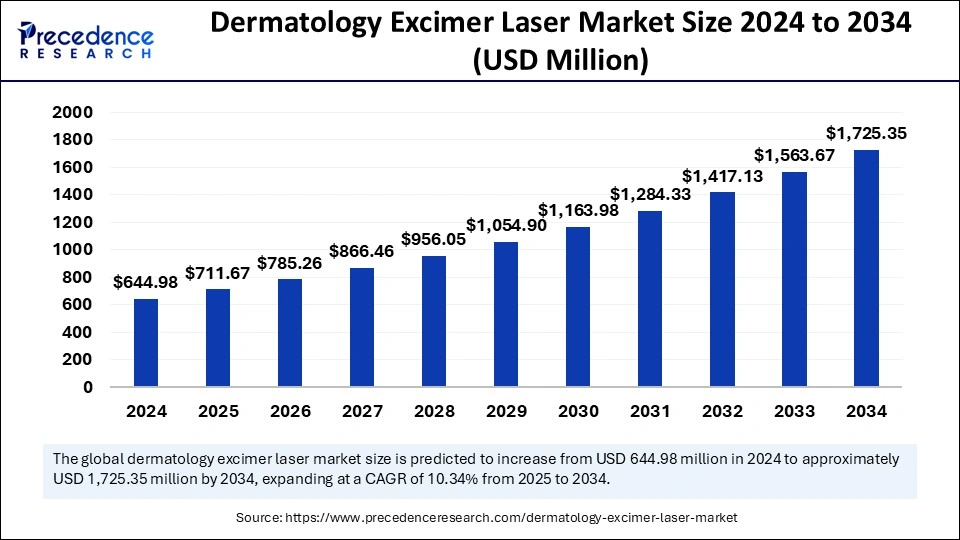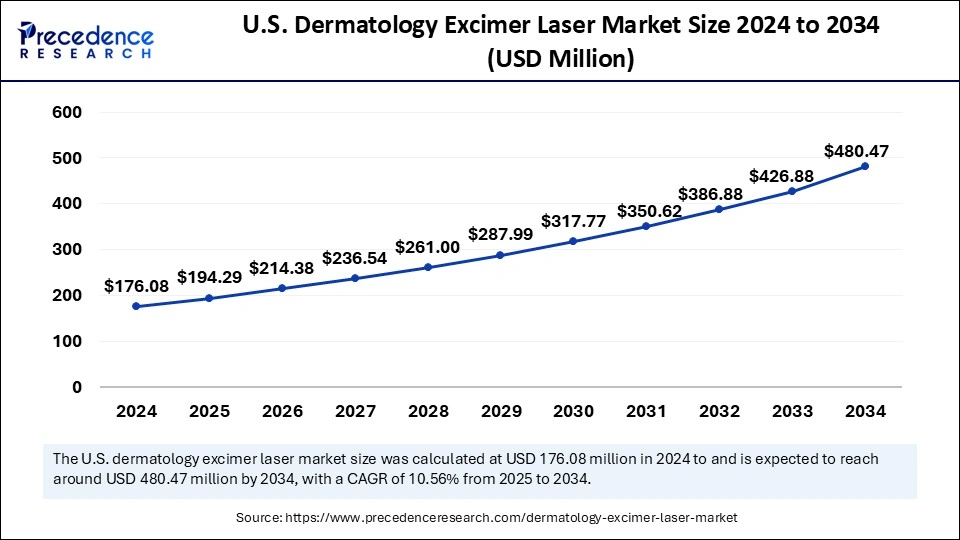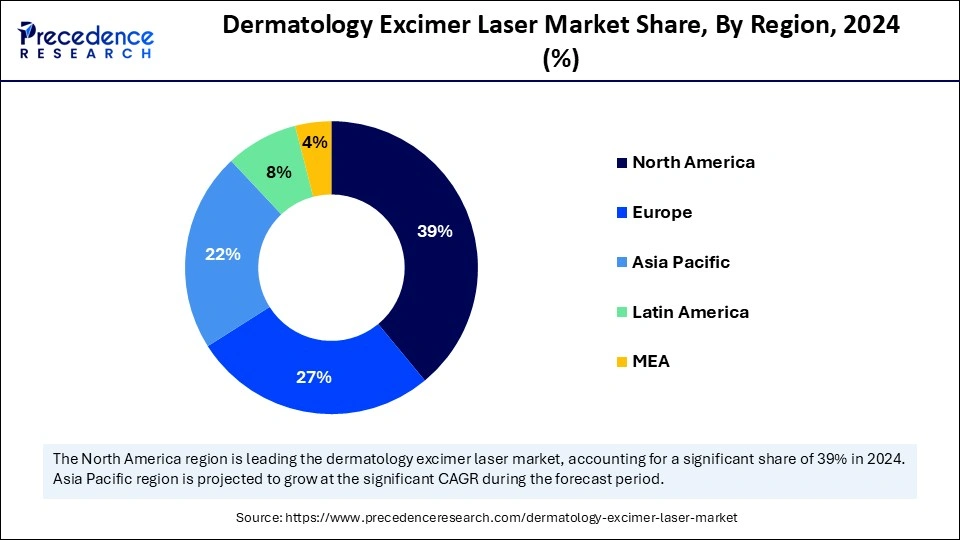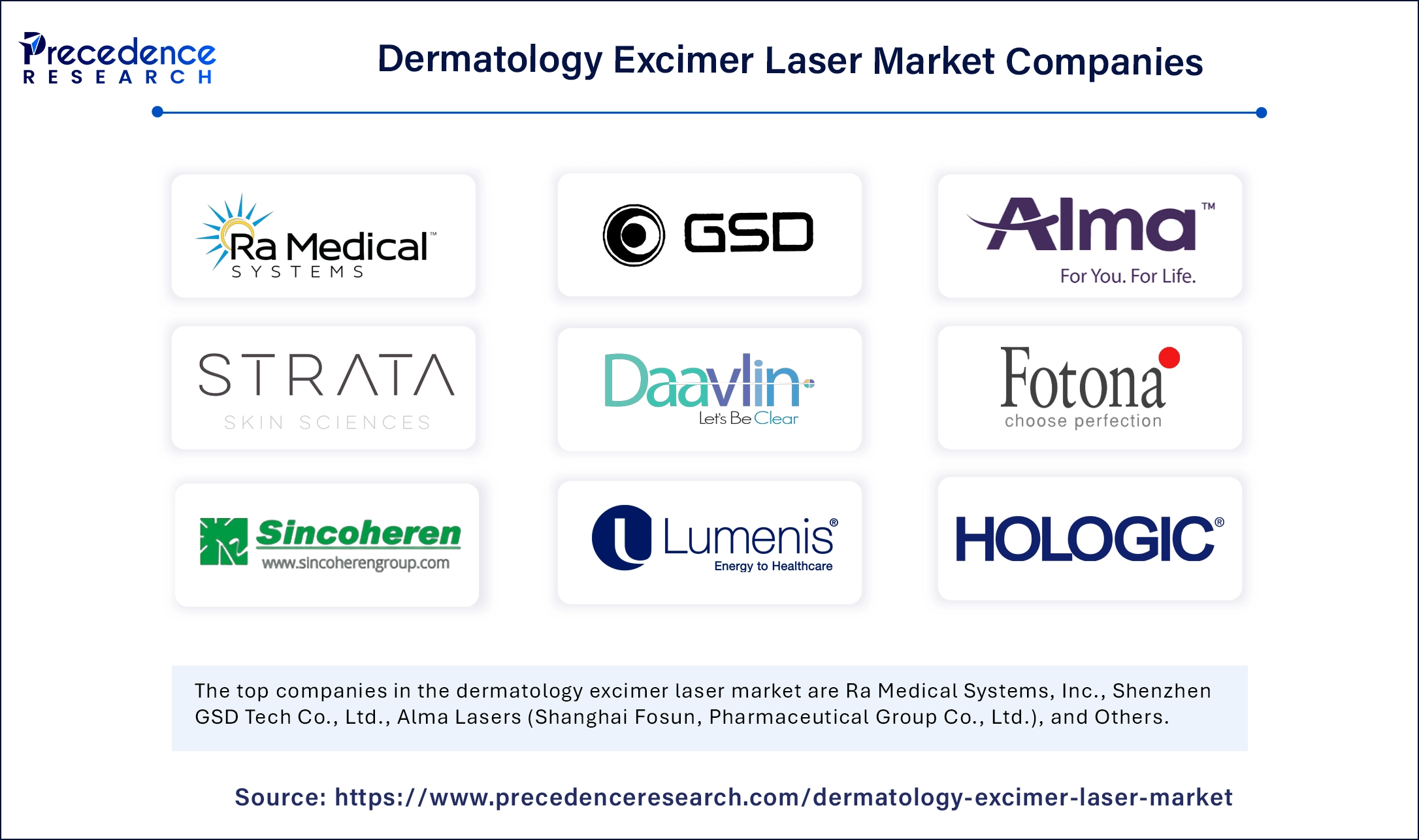November 2024
The global dermatology excimer laser market size is accounted at USD 711.67 million in 2025 and is forecasted to hit around USD 1,725.35 million by 2034, representing a CAGR of 10.34% from 2025 to 2034. The North America market size was estimated at USD 251.54 million in 2024 and is expanding at a CAGR of 10.56% during the forecast period. The market sizing and forecasts are revenue-based (USD Million/Billion), with 2024 as the base year.
The global dermatology excimer laser market size was estimated at USD 644.98 million in 2024 and is predicted to increase from USD 711.67 million in 2025 to approximately USD 1,725.35 million by 2034, expanding at a CAGR of 10.34% from 2025 to 2034. The growth of the dermatology excimer laser market is driven by the rising prevalence of skin diseases and high demand for cosmetic procedures.

Integrating artificial intelligence (AI) algorithms in dermatology excimer lasers significantly enhances treatment outcomes. AI-driven excimer lasers identify skin conditions and recognize skin type, aiding in precise diagnosis and assisting dermatologists in formulating personalized treatment plans tailored to individual patients. AI-laser technology transforms skin resurfacing using micro-columns of energy to penetrate deeply into the skin. AI-driven lasers analyze skin issues and adjust energy levels accordingly to deliver personalized treatments more safely and precisely. This precision lowers human errors and increases the outcomes of treatment and patients. AI-driven laser enhances diagnostic accuracy, enabling personalized treatment plans and improving the efficiency of cosmetic procedures.
The U.S. dermatology excimer laser market size was evaluated at USD 176.08 million in 2024 and is projected to be worth around USD 480.47 million by 2034, growing at a CAGR of 10.56% from 2025 to 2034.

North America dominated the dermatology excimer laser market by capturing the largest share in 2024. The region’s dominance is mainly attributed to the rise in incidences of skin diseases. Facial post-inflammatory hyperpigmentation, melasma, and solar dermatitis are the most often occurring skin diseases in North America.
The U.S. is a major contributor to the North American dermatology excimer laser market. The country is home to some of the leading medical device manufacturing companies, leading to rapid innovations in dermatology excimer lasers. The rising number of dermatology clinics and demand for cosmetic procedures further contribute to market growth.
Asia Pacific is anticipated to witness the fastest growth during the forecast period. There is a high burden of skin diseases, including atopic dermatitis, alopecia areata, acne, decubitus ulcers, contact dermatitis, psoriasis, seborrheic dermatitis, and pruritus, in Asian countries, particularly low-income countries. The rising awareness among people about the timely treatment of skin diseases also supports regional market growth. In China, the prevalence of skin diseases is high, affecting the overall health and well-being of people. The Chinese government is investing heavily to boost the development of novel surgical devices, contributing to the growth of the dermatology excimer laser market in the Asia Pacific.
India is expected to have a stronghold on the market. With continuous climate change, the number of cases of skin infection, irritation, and sunburn is increasing. This, in turn, boosts the demand for skin treatments. The rising healthcare spending further supports market growth. In addition, the Indian government programs like Ayushman Bharat aim to improve healthcare accessibility and provide free access to health insurance coverage for low-income groups, which contributes to market expansion.

Europe is observed to grow at a significant rate in the foreseeable future. The growth of the dermatology excimer laser market in Europe can be attributed to the increasing prevalence of skin diseases, such as skin fungal infection, acne, atopic dermatitis, alopecia, and psoriasis. The strong presence of excimer laser manufacturing companies such as Fotona d.o.o., EKA R&D Corp., Asclepion Laser Technologies GmbH, and Quanta System S.p.A. further drives the market. In addition, the rising demand for minimally invasive cosmetic procedures contributes to regional market growth.
The dermatology excimer laser market is growing rapidly due to the rising prevalence of skin disorders, such as acne and eczema, leading to a burden on healthcare systems worldwide. Thus, the high burden of subcutaneous and skin diseases increases the demand for dermatology excimer laser treatment. Excimer laser therapy uses a laser beam that emits ultraviolet (UV) light to target and treat specific areas of the skin. This therapy is a highly effective option that delivers targeted phototherapy for efficient and precise skin clearance. The rising awareness among people about skin health contributes to market growth. Excimer lasers increase efficacy in treating skin conditions like atopic dermatitis, psoriasis, vitiligo, allergic rhinitis, alopecia areata, and folliculitis. Moreover, the growing awareness about the benefits of minimally invasive procedures significantly boosts the growth of the market.
| Report Coverage | Details |
| Market Size by 2034 | USD 1,725.35 Billion |
| Market Size in 2025 | USD 711.67 Billion |
| Market Size in 2024 | USD 644.98 Billion |
| Market Growth Rate from 2025 to 2034 | CAGR of 10.34% |
| Dominated Region | North America |
| Fastest Growing Market | Asia Pacific |
| Base Year | 2024 |
| Forecast Period | 2025 to 2034 |
| Segments Covered | Product, Application, End Use, and Regions |
| Regions Covered | North America, Europe, Asia-Pacific, Latin America and Middle East & Africa |
Rising Prevalence of Refractory Pediatric Dermatological Conditions
The rising incidence of refractory pediatric skin disorders like atopic dermatitis (AD) and psoriasis is a major factor driving the growth of the dermatology excimer laser market. AD, in particular, is a chronic, inflammatory skin disease characterized by complex pathophysiology involving genetic predisposition, epidermal barrier dysfunction, immune dysregulation, and environmental triggers. As conventional treatments fail to achieve sustained relief in moderate to severe cases, particularly among children, there is a growing demand for targeted, non-invasive alternatives such as excimer laser therapy. This rising need for effective and precision treatments is propelling healthcare providers and dermatology centers to adopt excimer lasers, driving the growth of the market.
High Costs and Potential Side Effects
Excimer laser therapy is expensive, making it inaccessible to many patients. Excimer lasers are costlier and require continuous maintenance and repair, creating challenges for healthcare facilities and dermatology clinics, especially those operating with budget constraints. Handling these laser devices requires specialized training, which can increase overhead expenses, particularly in smaller or resource-limited settings. In addition, excimer laser treatments can cause skin irritations and scars, depending on time of application. This may create hesitation among patients undergoing excimer laser therapy, limiting the growth of the market.
Expansion of Teledermatology
The rising integration of teledermatology in healthcare practices creates immense opportunities in the dermatology excimer laser market. By enabling the remote diagnosis and management of skin conditions through high-resolution imaging and digital communication platforms, teledermatology increases access to specialist care, particularly in rural and underserved regions. This shift not only enhances diagnostic accuracy and care continuity but also drives demand for decentralized treatment solutions, including portable and clinic-friendly excimer laser systems. This trend supports the wider deployment of excimer laser devices in teledermatology-enabled hospitals, fueling the growth of the market.
The trolley-mounted excimer laser segment led the dermatology excimer laser market with the largest share in 2024. This is mainly due to the increased preference of these lasers in dermatology clinics for their enhanced accuracy and ability to treat various skin diseases. These lasers improve the delivery and precision of UVB energy to targeted tissue. The rise in the preference for precision results and faster therapeutic benefits further bolstered the segment. These lasers deliver UVB light in an adequate amount, reducing the total number of treatments required and the risk of side effects and skin cancer.
The handheld excimer laser segment is expected to expand at the highest CAGR during the forecast period. These lasers are widely preferred for their portability and user-friendly features. Handheld systems are majorly applied for intense monochromatic UVB therapy and in treating skin diseases like vitiligo and psoriasis. Dermatologists can easily move this handheld device over the surface of the patient’s skin, enhancing comfort and flexibility. These lasers are suitable for both hospital and home settings.
The psoriasis segment held the largest share of the dermatology excimer laser market in 2024. This is mainly due to the heightened demand for targeted and minimally invasive therapies. The excimer laser is efficient for inducing apoptosis in T lymphocytes and keratinocytes, which are the two main cells involved in the pathogenesis of psoriasis. Huge doses of excimer laser therapy also lower the number of pathogenic memory T cells that penetrate the lesional dermis and epidermis in psoriatic lesions, reducing inflammation in the clearance of psoriatic lesions. Excimer lasers are highly effective in the treatment of psoriasis due to their ability to target specific areas, reducing damage to healthy skin tissues.
The vitiligo segment is anticipated to grow at the fastest rate in the upcoming period as excimer laser therapy, along with topical immunosuppressive treatment, is recommended in vitiligo treatment. The excimer laser is a workable management therapy for vitiligo and may yield results greater than other therapies. Excimer lasers allow for precise targeting of vitiligo patches, enhancing treatment outcomes.
The dermatology clinics segment dominated the dermatology excimer market in 2024. This is mainly due to the increased patient pool in dermatology clinics. These clinics are often equipped with advanced surgical devices and skilled staff, encouraging patients to receive care from these settings. The rise in the number of cosmetic surgeries performed in these settings further bolstered the segmental growth. These settings also offer personalized care, attracting more patients.
The plastic surgery centers segment is anticipated to witness the fastest growth during the forecast period. The precision and versatility of excimer lasers make them ideal for achieving optimal results with minimal risks and reduced downtime. Excimer laser treatments have revolutionized the area of plastic surgery. These lasers effectively address a broad range of cosmetic challenges, including scar reduction, skin rejuvenation, and hair removal in the plastic surgery center. The rising demand for cosmetic surgeries further contributes to the growth of the segment.

By Product
By Application
By End-use
By Region
For inquiries regarding discounts, bulk purchases, or customization requests, please contact us at sales@precedenceresearch.com
No cookie-cutter, only authentic analysis – take the 1st step to become a Precedence Research client
November 2024
November 2024
December 2024
November 2024